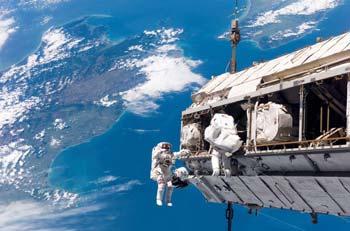Source: nasa
09-18-2008 15:27
Extra-vehicular activity (EVA) is work done by an astronaut away from the Earth and outside of a spacecraft. The term most commonly applies to an EVA made outside a craft orbiting Earth (a spacewalk) but also applies to an EVA made on the surface of the Moon (a moonwalk).
 |
| S116-E-05983 (12 Dec. 2006) --- Backdropped by a colorful Earth, astronaut Robert L. Curbeam, Jr. (left) and European Space Agency (ESA) astronaut Christer Fuglesang, both STS- 116 mission specialists, participate in the mission's first of three planned sessions of extravehicular activity (EVA) as construction resumes on the International Space Station. The landmasses depicted are the South Island (left) and North Island (right) of New Zealand. |
In the later lunar landing missions (Apollo 15, 16, and 17) the command module pilot did an EVA to retrieve film canisters on the return trip; he was assisted by the lunar module pilot who would perform a stand up EVA. These trans-Earth EVAs were the only spacewalks ever conducted in deep space to date.
Due to the different designs of the early spacecraft, the American and Soviet space programs also define an EVA differently. Russians define an EVA as occurring when a cosmonaut is in a vacuum. An American astronaut EVA begins when the astronaut switches the Extravehicular Mobility Unit (EMU) to battery power. The term stand-up EVA (SEVA) is used for being partly outside.
EVAs may be either tethered (the astronaut is connected to the spacecraft, oxygen can be supplied through a tube, no propulsion is needed to return to the spacecraft) or untethered. When the tether performs life support functions such as providing oxygen, it is called an umbilical.
Untethered spacewalks were only performed on three missions in 1984 using the Manned Maneuvering Unit (MMU), and on a flight test in 1994 of the Simplified Aid for EVA Rescue (SAFER). The latter is a safety device worn on tethered US EVAs, since the capability of returning to the spacecraft is essential.
Editor:Yang Jie
